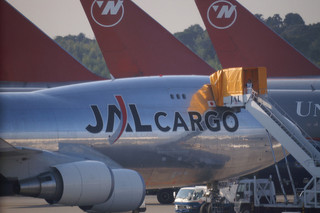 Global air cargo traffic in July continued with the modest improvement experienced in June, pushing airfreight volumes to their highest level since mid-2011, according to the International Air Transport Association (IATA).
Global air cargo traffic in July continued with the modest improvement experienced in June, pushing airfreight volumes to their highest level since mid-2011, according to the International Air Transport Association (IATA).
Airfreight throughput was up 1.2 percent in July from the same period last year, a slightly better performance than the 0.9 percent year-on-year increase recorded in June, as growth in Europe and the Middle East offset weakness in Asia.
“The growth is encouraging, particularly in Europe,” said Tony Tyler, IATA’s Director General and CEO. “However, it is premature to say that air cargo may be emerging from the doldrums of the past 18 months. The weakness in Asia-Pacific freight markets and the deteriorating political situation in parts of the Middle East give ample reason for continued caution.”
Capacity increased 3.4 percent versus July 2012, pushing load factor down to 43.3 percent. However, load factors have stabilized compared to earlier in 2013, an association release said.
By region, airlines in Europe, the Middle East, and Latin America contributed to the improved performance versus a year ago.
Asia-Pacific carriers’ cargo demand fell 1.4 percent compared to July 2012, while capacity climbed 2.6 percent. Asia-Pacific airlines have seen airfreight contract 2.1 percent through the first seven months of 2013, the largest decline among regions, according to IATA figures.
Business activity in China remains sluggish. Moreover, the weakness has extended to emerging Asia, where trade volumes have shrunk almost 5 percent in the first half of the year.
European carriers experienced a 1.5 percent increase in demand in July, while capacity climbed 3.5 percent. July was the second consecutive month in which airfreight demand increased, giving rise to cautious optimism.
North American airlines had another month of weak demand for airfreight in July. Cargo traffic fell 1.1 percent compared to the year-ago period, contributing to a 1.7 percent contraction in the first seven months of 2013 versus last year.
Middle East airlines led all regions with a 14.4 percent rise in demand compared to July 2012. Capacity climbed 11.1 percent. Year-to-date demand was up 11.7 percent. Part of the rise in year-on-year growth rates in July is the timing of Ramadan, which took place mostly in July 2013 against August in 2012.
Latin American carriers’ cargo traffic rose 3.1 percent in July compared to a year ago, with capacity up just 1.7 percent. This result was broadly in line with the region’s performance during the first seven months of the year, when volumes rose 3.4 percent.
African airlines experienced a 4.9 percent contraction in July year-on-year. Despite a year-to-date cargo growth of 2.2 percent, airlines in the region continue to face intense competition for their product.
Photo: Hyougushi




